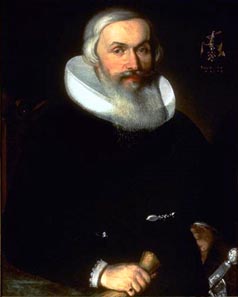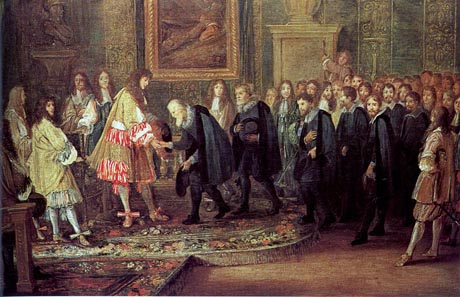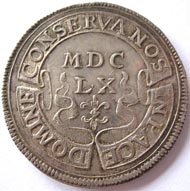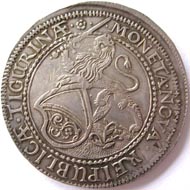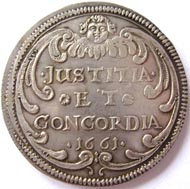courtesy of Jürg Conzett / MoneyMuseum Zürich
In the first half of the seventeenth century Zurich was not much bigger than a today’s suburban quarter. Some 9,000 inhabitants lived in the town, however only around 1,500 out of these were actually citizens and hence men who could express their political opinion. A small circle indeed, a circle where solidarity was at home – but envy, grudge and calumniation, too.
Portrait of Johann Heinrich Waser dated 1654, painted by Conrad Meyer. Oil on canvas. Schweizerisches Landesmuseum Zürich. http://webcollection.landesmuseen.ch / Wikipedia.
Johann Heinrich Waser (1600-1669), elected mayor of Zurich on June 28, 1652, was very well aware of these facts. During his first employment as an unsalaried clerk in Zurich’s municipal office he understood that every gift he received from grateful subjects or peers might arise envy among the other citizens. Hence Waser endeavoured to have always evidence at hand to justify his actions by registering in written form all costs and revenues related to his offices. We dispose of a bunch of financial details regarding Waser’s career. We know for instance that Waser paid 30 pounds (corresponding to 600 Zurich shillings or 8 1/3 talers) for entering a guild; further he had to afford freely a communal drink at an expense of additional 27 pounds or 540 Zurich shillings corresponding to 7 1/2 talers.
Particularly thorny were those presents Waser received from his negotiating partners when he travelled as Zurich’s ambassador. Although this was common practice they might have been interpreted as bribery anyhow. Hence Waser was especially precise on this account. Let’s consider an example at haphazard: Waser took 469 guldens and 24 shillings (equalling to 18,784 Zurich shillings or 261 talers) from the Grisonians in 1644. Previously he had acted there as conciliator in the course of a quarrel between Davos and Glarus on behalf of the city of Zurich. Thus Waser informed the officials in Zurich about this gift and with that money he paid his travel expenses of 169 guldens and 24 shillings (equalling 6,784 Zurich shillings or 94,2 talers); otherwise this sum would have been paid by the Zurich administration. From his hometown he asked only his travel companion’s wages for this tedious mission. Another example are a dozen of gilt cups weighing 108 lots (equalling 8,640 Zurich shillings or 120 talers) bestowed on him by the vicar of Kyburg, who was grateful because Waser had augmented his revenue significantly. Hence, at those days gifts for politicians were common practice and were not considered bribery, yet. These gifts were sleazy only if a mighty man had compelled his subjects to make a costly present, or even worse, if costly presents had influenced the presentee’s opinion in Zurich’s disfavour.
In 1633 Louis XIV receives a delegation of the Swiss Confederacy led by Johann Heinrich Waser. Painting by Adam Frans van der Meulen. Source: Wikipedia.
Exactly of this offence Johann Heinrich Waser was guilty – as people murmured mystifyingly – due to his behaviour in Paris during the adjuration of the 1663 pay contract with Louis XIV. France had virtually extorted this pay contract threatening with economic sanctions. Being a political realist Waser nevertheless had argued in favour of the contract. His opponents – especially previous mercenaries employed by France – did not object basically to the contract. But they claimed all back pays to be cashed out before concluding the contract since the King of France owed them around 912,933 French Francs (equalling to ca. 22,823,325 Zurich shillings or 316,991 talers). However, their demand was completely fanciful. Neither was France capable of paying this amount of money since it was still recovering from Fouquet’s mismanagement, nor had it to do so because France had the whip hand over the mercenaries anyway, as it could inflict most serious losses to Zurich simply by revoking all trading privileges.
Most members of the Zurich government backed Waser’s realistic policy, however a minority did not accept Zurich’s impotence and helplessness and thus scapegoated Waser. All over again and even before the contract had been signed, the council examined the allegations made against the mayor by citizens (usually drunken while committing the offense). Not one of them was proved by evidence. Therefore all defamers had to pay a fine. Rittmeister Hirzel, just to cite an example, had to pay 150 mark silver (corresponding to 15,000 Zurich shillings or 208 talers) since he had called Waser a ‘disloyal regent’ who virtually courted ‘insurrections’.
By contrast the honorary gift bestowed on Waser by king Louis XIV after the solemn oath on the pay contract does not look so lavish. It consisted of chains, honorary medals and cash totalling to 2,305 guldens (corresponding to 92,200 Zurich shilling or 1,281 talers). The gifts’ value was determined by an officially appointed valuer, mint master Hans Heinrich Simmler. The Council decided that all ambassadors should keep their presents and, in addition, they were paid back all expenses they had had to afford during their stay in France. Obviously after Waser’s return the presents he had taken were not at all considered illegal.
So-called wasertaler showing a floral element on the reverse sometimes maliciously interpreted as French fleur-de-lis. © Sturzenegger Stiftung / Museum zu Allerheiligen / Schaffhausen.
Only the rumour mill created in the following time stories about a small barrel full of gold, allegedly seen by a customs official in Mellingen; and reportedly a servant of Waser carried a knapsack of gold home when returning from France. In a 1669 lawsuit all these allegations were disproved and Waser was completely rehabilitated. However, even then rumours persisted. Waser was no longer able to face that campaign anyhow because since the trial he had been on his deathbed.
Zurich taler overstruck on wasertaler – traces of the original issue are clearly visible, particularly on the obverse. © Sturzenegger Stiftung / Museum zu Allerheiligen / Schaffhausen.
Those who cannot speak for themselves are perfect scapegoats. Therefore, it was Waser who was made responsible in the streets of Zurich for having concluded the contract with Louis XIV. When the natives of Zurich perceived that this contract did not even ensure the desired advantages, their discontentment grew and discharged in a personal refusal of Waser. Obvious signs of this event are the overstruck wasertaler; these coins were struck over taler not yet wear off which had been issued in 1660 by order of mayor Waser and treasurer Schneeberger. People interpreted the small adornment on the reverse of these coins as fleur-de-lis. Waser was said to have shown by doing this pro-French sympathies in 1660, already. As the citizens of Zurich refused to use these talers for transactions, the government had to withdraw them and reissued the coins. A small barrel of wasertaler escaped this fate because it had been stored in the official treasure where it was maybe forgot. In 1798 French soldiers discovered this barrel, confiscated it and brought its content into regular circulation. Due to that fact this very rare evidence from the time of the maligned mayor Waser has survived until now.
Further reading:
Norbert Domeisen, Bürgermeister Johann Heinrich Waser (1600-1669) als Politiker. Ein Beitrag zur Schweizer Geschichte des 17. Jahrhunderts. Bern 1975.
The text is taken from the brochure ‘Die Zürcher und ihr Geld’ were it was published in occasion of the eponymous exhibition of the Landesmuseum Zürich in collaboration with MoneyMuseum Zürich in the Bärengasse Museum in 2006. There you may find the same text (only in German, however) annotated scientifically.
The coins shown are property of the Museum zu Allerheiligen. You can learn more about this museum here.
For further information on the publications of the MoneyMuseum, just click here.
This link leads you directly to the MoneyMuseum collection.



